 Petzlover
PetzloverEstonian Hound is originated from Estonia but Serbian Mountain Hound is originated from Serbia. Both Estonian Hound and Serbian Mountain Hound are having almost same height. Both Estonian Hound and Serbian Mountain Hound are having almost same weight. Estonian Hound may live 3 years more than Serbian Mountain Hound. Both Estonian Hound and Serbian Mountain Hound has same litter size. Estonian Hound requires Moderate Maintenance. But Serbian Mountain Hound requires Low Maintenance
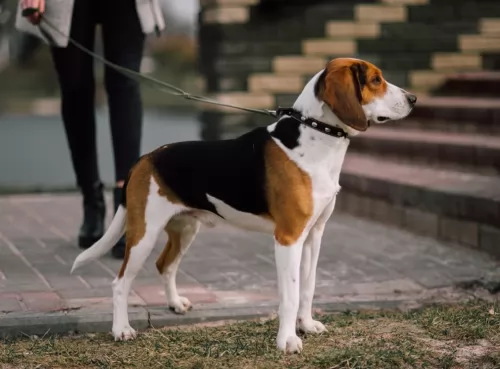 In 1947, the Estonian Hound was developed and remains today the only pure breed ever developed in Estonia. At that time the national economic minister of the Soviet Union declared that every country in the USSR must have a national dog breed. Thus, the Estonian Hound and the Estonian Kennel Union were born. The Kennel Union is currently seeking breed recognition from the Federation Cynoloqique Internationale.
In 1947, the Estonian Hound was developed and remains today the only pure breed ever developed in Estonia. At that time the national economic minister of the Soviet Union declared that every country in the USSR must have a national dog breed. Thus, the Estonian Hound and the Estonian Kennel Union were born. The Kennel Union is currently seeking breed recognition from the Federation Cynoloqique Internationale.
The Estonian Hound came from breeding local Estonian hunting dogs with several different breeds of foreign dogs. The Soviet decree also established that hunting dogs had to be no more than 17 inches high. This result in a hunting dog with great agility and drive that is extremely popular in now inependent Estonia. It is the national dog.
Known as the Srpski Planinski Gonic dog and coming from Yugoslavia, the Serbian Mountain Hound is one of two modern hounds that was once known as the Yugoslavian Mountain Hound or Jugoslovenski Planinski Gonic.
There isn't much information on the origins of the dogs. These two dogs are considered similar breeds, only varying in region. Its a hunting dog thought to have descended from Asian search dogs.
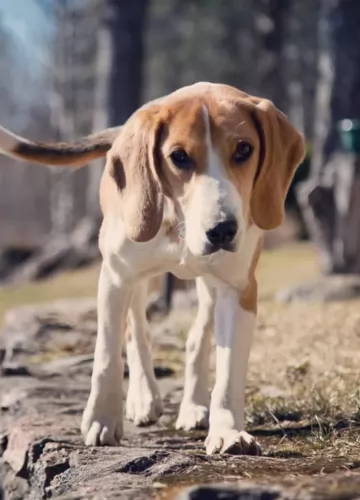 The Estonian Hound is a strong, muscular body of medium size, with well-developed muscles and strong bones. It has a straight muzzle and skull with defined eyebrows and long drop ears. They have black noses and dark eyes. Their back is wide and straight, and their chest is deep and wide. They have skin that is tight with no wrinkles or folds anywhere.
The Estonian Hound is a strong, muscular body of medium size, with well-developed muscles and strong bones. It has a straight muzzle and skull with defined eyebrows and long drop ears. They have black noses and dark eyes. Their back is wide and straight, and their chest is deep and wide. They have skin that is tight with no wrinkles or folds anywhere.
The Estonian Hound is double coated, but the undercoat is not well developed. The top coat is rough, short and shiny. The tail has a thick covering of hair. The color is usually white with red patches, black or brown patches or yellow patches.
The Serbian Mountain Hound is about 46 to 50cm in height and weighs around 18 to 22 kilograms. This Yugoslavian hound breed has been used in Serbia as a hunting dog and they are thought to be rare outside of Serbia.
The coat of the newer Mountain Hound is fairly short and thick and mainly black with some tan marks around the paws and muzzle. The dog has floppy ears and a long tail.
This is a hardy scent hound that is confident and bold. They are used to hunting on rough terrain in the Balkan region. They are independent dogs and training and socialization will refine them, making the dog obedient and well mannered.
When he isn’t outdoors, he becomes a good-natured, gentle amiable dog that is good with children in the home.
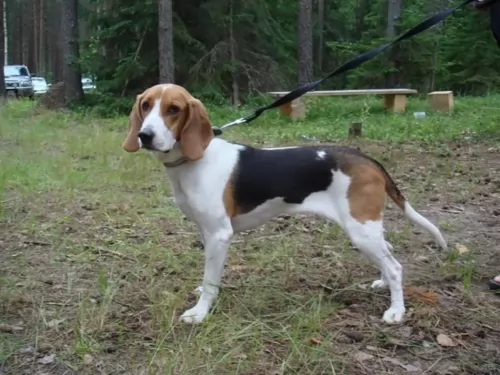 The Estonian Hound is a happy dog and loves to play with children. He was bred to hunt though and he can get fixated on a scent and knock over a small child.
The Estonian Hound is a happy dog and loves to play with children. He was bred to hunt though and he can get fixated on a scent and knock over a small child.
He is a hunting dog with great agility and drive.
He has had to be adaptable through his short history and is now more a companion than a hunting dog. He can live in the city or country.
He is intelligent and trainable. He is lively and energetic and the challenge might be keeping his attention long enough to train.
The Serbian Mountain Hound is such a social, happy, friendly kind of dog that he makes a wonderful family pet.
He learns well, he likes to please, he gets on well with children and dogs in the home, he is independent and not a noisy barker. He is also fairly low maintenance.
Take good care of him and you’re guaranteed to have a wonderful pet and companion.
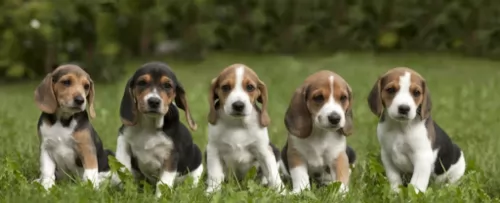 With such a young breed there have not been any studies done on their health or genetic issues. It seems the breed is fairly healthy but there is too little information to really say. Being confined to Estonia there has been little commercial or backyard breeding. He is less likely than most pure breeds to have genetic issues.
With such a young breed there have not been any studies done on their health or genetic issues. It seems the breed is fairly healthy but there is too little information to really say. Being confined to Estonia there has been little commercial or backyard breeding. He is less likely than most pure breeds to have genetic issues.
It is likely that dogs of his type are at risk for:
Caused by excessive exercise before or after having eaten a large meal. It is suggested that you feed your English Setter twice a day, smaller meals and not right before or after strenuous exercise.
Nobody wants their dog to be sick and lethargic, after all they are our best friend’s. Some ways to check the status of your dog’s health -
Check his breath, as a bad breath, just like as with a human being, can be a sign of illness. It can also be indicative of dental problems, digestive or kidney problems.
Spread his fur and check that the skin is a healthy color – pink, grey or black. Make sure there is no crusting or itching with red, inflamed areas. Make sure the coat is thick and lustrous – not falling out and thinning.
Make sure the nails aren’t split, flaking and broken and that the paws aren’t cut so that the dog is constantly licking them.
Every dog drinks a lot of water after hectic exercise, but if your dog suddenly becomes very thirsty more than usual, it could be indicating a medical problem, and you will need to discuss it with your vet.
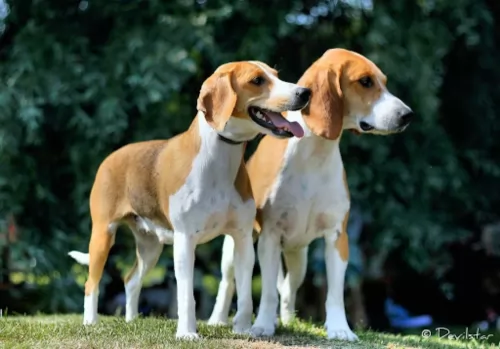 Feed a high quality dry food made for puppies. Feed ¼ to ½ cup per day in 2-3 meals for the first six months.
Feed a high quality dry food made for puppies. Feed ¼ to ½ cup per day in 2-3 meals for the first six months.
Feed 1 to 2 cups in two meals from 6 months to a year or so.
Feed about 2 to 3 cups in two meals.
As previously mentioned this seems to be a fairly healthy breed.
Be careful not to feed a large meal before or after exercise due to possibility of bloat.
Check their ears and clean them periodically.
The Estonian Hound is a hunting dog and needs a good deal of exercise – at least an hour and a half every day or a long walk if not used for hunting. He is a working dog with a lot of energy and stamina. Don’t let him off leash though or he will follow his nose and take off. He is usually calm and quiet indoors if he gets enough physical and mental stimulation outdoors. He can be destructive and loud, nervous and hyper if he doesn’t. They enjoy Frisbee, agility, tracking and of course hunting.